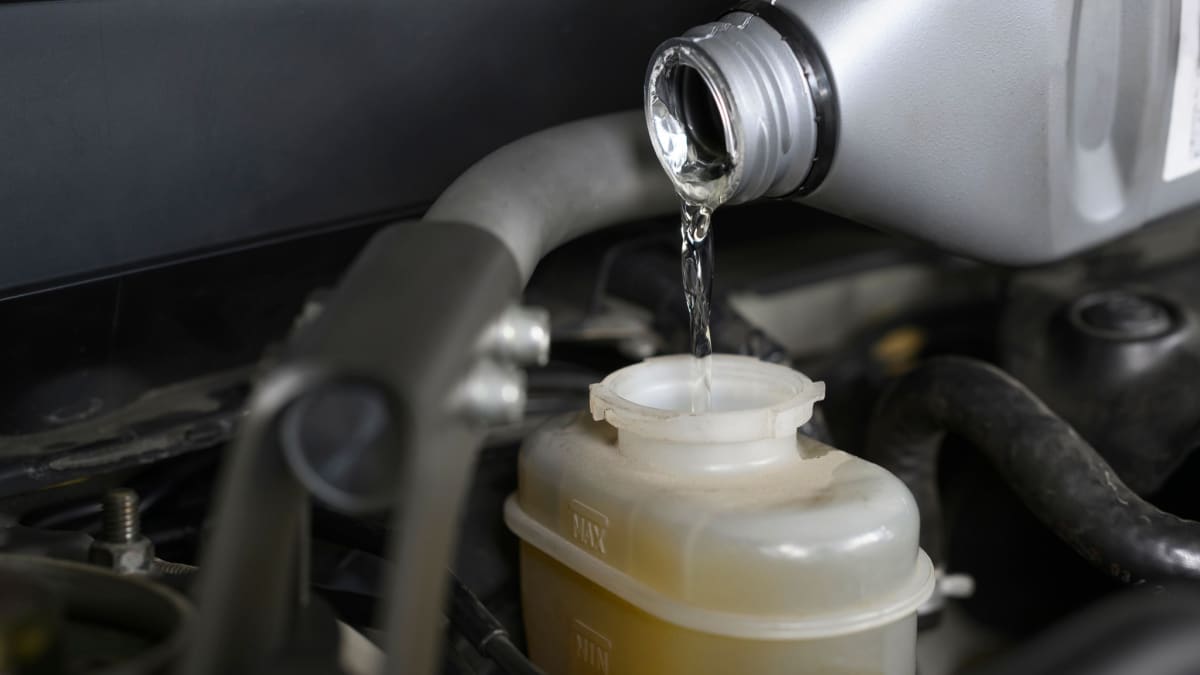If you know what you’re looking at, everything can be a clue to help you figure out what’s going on. It’s how Sherlock Holmes solves his crimes, and that’s how you can break down what’s happening inside your transmission.
After reading this guide, you’ll have a better understanding of what you’re looking for and know what to do after you check your transmission fluid.
Color of Transmission Fluid
- Pink – Coolant Mixed with Fluid
- Red – New or Like New Condition
- Light Brown – Good Condition
- Dark Brown – Old & Slightly Burnt
- Very Dark Brown or Black – Very Old & Burnt
If you know what you’re looking at, the different colors you see in your transmission fluid can tell you quite a bit. Below, I’ll highlight the five most common colors and tell you what each one means!

1. Pink
If you check your transmission fluid and it’s more pink than red, you have a problem. Pink transmission fluid means that water’s getting into the system. Typically, this water is actually coolant, and it means you have some faulty gaskets that you need to replace.
If the fluid is pink, you won’t just need to replace the fluid; you’ll need to repair and potentially rebuild the transmission.
2. Amber or Light Red
If you check your transmission fluid and it has a light red or amber color, this is ideal. It’s fresh transmission fluid, and this is precisely what it’ll look like after a fluid change. Not only will the transmission fluid have a bright red color, but it will also be semi-translucent.
Keep in mind that it won’t maintain this color for long, and it will start to transition to a maroon color after only a few thousand miles.
3. Maroon
If your transmission fluid has a maroon tint, that’s perfectly alright. All that it means is that the transmission fluid has some wear. It doesn’t mean that you need to replace it yet.
Your transmission fluid will start to have a maroon tint after just a few thousand miles, and will stay this way for most of its service life.
4. Brown
As your transmission fluid ages, it goes from a bright and semi-transparent amber all the way to an opaque brown color. Once it reaches this stage, it’s time to start considering replacing your transmission fluid.
Most vehicles won’t require a transmission fluid change until they hit the 100,000-mile threshold, and that’s when the fluid will start to reach this darker brown stage.
5. Black
If your transmission fluid is black, it’s a cause for concern, and it’s time to replace the fluid. Black transmission fluid is oxidized and burnt, which means that it’s no longer providing the necessary lubrication for your transmission system.
If you pull the dipstick and the transmission fluid is black, get a fluid flush as soon as possible before it grows into more significant problems.
Transmission Fluid Basics

For starters, transmission fluid is a sealed system. That means nothing should be getting in there unless you put it there.
Furthermore, it wears down with use. It’s just like oil – it just has a much longer service life. That means if you’ve never changed your transmission fluid before, it might be due for a change.
The exact service intervals vary by manufacturer, but most vehicles require transmission fluid oil changes every 100,000 to 150,000 miles. It’s also something the dealership tries to push in far more frequently.
For example, this dealership in Fort Worth, Texas, recommends that you change the transmission fluid every 30,000 miles. Meanwhile, Ford only recommends changing your transmission fluid every 150,000 miles in the exact same model. Don’t fall for it – go with the manufacturer recommendations, not the dealership.
Transmission fluid serves a wide array of purposes inside your transmission, which is why it’s so important to make sure that it’s in good working order.
Not only does it keep everything lubricated, but it also keeps everything cool and cleans the inside of your transmission. As long as you keep the transmission fluid in good working order, there’s no reason that an automatic transmission can’t last over 200,000 miles.
Other Causes for Concern

If you pull the dipstick and see metal shavings, this a significant concern. It means that the internal workings of your transmission are grinding together, shaving itself down. If you see this, it’s time to rebuild your transmission, and there is a good chance you’ll need to replace it.
You should also check for metal shavings whenever you drain the transmission fluid completely, as this is when you’ll have the highest likelihood of spotting any concerns.
When you check the fluid with the dipstick, actually touch it with your fingers. When you have the transmission fluid on your fingers, rub them together. It should be smooth. If you feel any dirt or grime, this means that something is going on with your transmission and contaminating the fluid.
Drain the fluid out and take a closer look at the drained fluid to see if you can’t find any more particles. If you find anything else, you need to have the transmission serviced and potentially rebuilt.
Finally, when you pull the dipstick, smell the fluid. It might look weird if someone doesn’t know what you’re doing, but it’s an essential piece of the puzzle. The transmission fluid should smell fresh – if it gives off a burnt odor, that’s a sign that the oil is past its prime.
Moreover, if the transmission fluid isn’t old, it’s a sign that something else is going on inside your transmission. While a slightly burnt smell doesn’t mean you should go right out and rebuild your transmission, you should keep an eye on it to make sure that it’s not getting worse.
There’s no arguing that your vehicle’s transmission is essential. The good news is that transmission fluid acts as a looking glass to give you an idea of your transmission’s overall health. All it takes to check it is to pull out the dipstick!
Finally, if everything looks good with your transmission fluid’s color and it’s still within the manufacturer’s specifications, there’s no reason to change it. Transmission fluid can last a lot longer than oil – don’t let a shady dealership or repair shop try to tell you otherwise.
Categories: Maintenance, Transmission
















